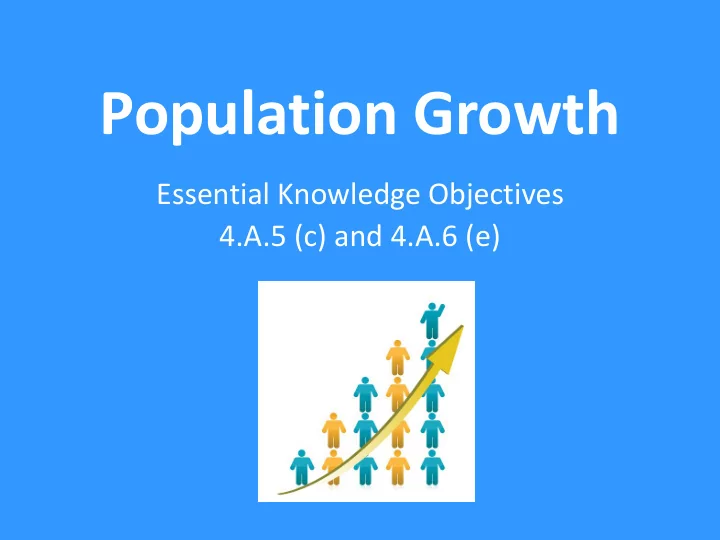

Population Growth Essential Knowledge Objectives 4.A.5 (c) and 4.A.6 (e)
Population Growth Patterns • Mathematical models and graphical representations are used to illustrate population growth patterns and interactions • What are two population growth patterns?
Birth Rate and Death Rate • Birth rate (B): number of offspring produced per unit time 34/1000 = 0.034 (per capita birth rate) • Death rate (D): number of individuals that die per unit time 16/1000 = 0.016 (per capita death rate) • Used to estimate population growth
Exponential Growth • Reproduction without constraints (such as?) • Rapid, unrestricted growth • r max = max per capita growth rate • N = population size
Logistic Growth • Growth is limited due to density-dependent and density-independent factors • Rate of population growth slows as the population size (N) approaches the carrying capacity (K)
Logistic Growth • r max = maximum growth rate of a population under ideal conditions • K-N = number of individuals the environment can support • (K-N)/K = fraction of the carrying capacity that is still available for population growth
Carrying Capacity (K) • The maximum number of individuals that a given environment can support
Limiting Factors • Factors that prevent a population from growing any larger or cause a population to decrease What are the two categories of limiting factors?
Density-Dependent Factors • Factors that are dependent on the number of individuals in a given area (population size) • Often biotic factors Examples: competition for resources, disease, predation
Density-Independent Factors • Factors that affect all populations in similar ways regardless of population size (density) • Often abiotic factors Examples: drought, extreme temperatures, natural disasters
Trade Offs and Life Histories • Traits that affect an organism’s schedule of reproduction and survival make up its life history • Trade off between quantity (reproduction) and quality of offspring (survival) • Natural selection decides K-selection r-selection
r and K Selected Species
K-selected • K for carrying capacity • Population lives at a density near the carrying capacity, stronger competition • Produce few “expensive” offspring and live in stable environments
r-selected • r for reproduction, maximize reproductive success • Density of population is well below the carrying capacity, minimal competition • Produce many “cheap” offspring and live in unstable environments
Life Histories
Recommend
More recommend